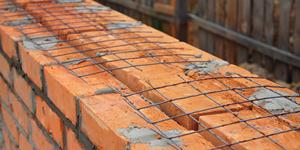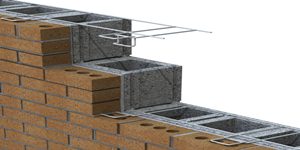Role of Reinforcement in Construction
Reinforcement in construction is to provide tensile strength to the concrete structures. Ordinary brick masonry cannot withstand tensile stresses because bricks get pulled apart at the mortar joints, in such situations, brick masonry is reinforced by steel flats, steel bars or expanded bars.
In general, reinforced brickworks are used in lintels, retaining walls, in seismic zones and walls built on soil that is susceptible to a large settlement.
Brick Masonry
Most of the times, brick columns are strengthened with bars to increase their compressive load-carrying capacity and are grouped into reinforced brick lintels, reinforced brick columns, reinforced brick walls, and reinforced brick slabs.
Reinforced Brick Lintels:
In this type, longitudinal reinforcement consists of bars of 6-12 mm diameter, while vertical stirrups are 6 mm in diameter. The vertical stirrups are placed at every third point.

Reinforced Brick Columns:
For this construction, a special type of bricks are used which have grooves for vertical reinforcement and by reinforcing the load-carrying capacity of the column is increased. At every fourth course, they are provided with horizontal steel plates of 6 mm thickness and vertical steel bars are used in the foundation concrete blocks.

Reinforced Brick Wall:
Walls that are prone to tensile forces are needed to be reinforced, and both horizontal and vertical reinforcement is required.
Horizontal reinforcement is provided at every third or fourth course, consists of steel mesh spread flat on the cement mortar and pressed uniformly. These flats are dipped in molten tar to increase their resistance against rusting. Generally, one strip is provided for every thickness of half a brick, and at the ends, the bars are beaten flat, and at the junction, the bars crossing each other are interlaced.

Vertical reinforcement is provided by using special bricks that have grooves to pass the bars. Mild steel bars of 6 mm diameter is used and are tied at suitable intervals with fine wires.
Reinforced Brick Slab:
If bricks are to be used for the construction of slab, they should be reinforced with steel, and for that, a wooden platform is built, which is covered with well-beaten earth. After, fine sand is sprinkled over which mortar layer is spread, and special bricks with grooves are then laid in one or two courses. The joints are filled with mortar, and the slab is cured for three to four weeks. The top and bottom surfaces are suitably finished to complete the process.

Reinforced Concrete:
Reinforced concrete is used in structural components like slabs, beams, columns, foundations, etc. In general, concrete has a low tensile strength and durability, but after reinforcement, it gains higher strength and durability. Reinforcing is needed to resist tensile stresses which might cause cracking or structural damage.
Know more about the Types of Steel Reinforcement in Construction
Technically Reviewed by Rajesh Pagadala, MS, Founder & CEO - BuildersMart. Written by Vani paspula, Content Manager.

















